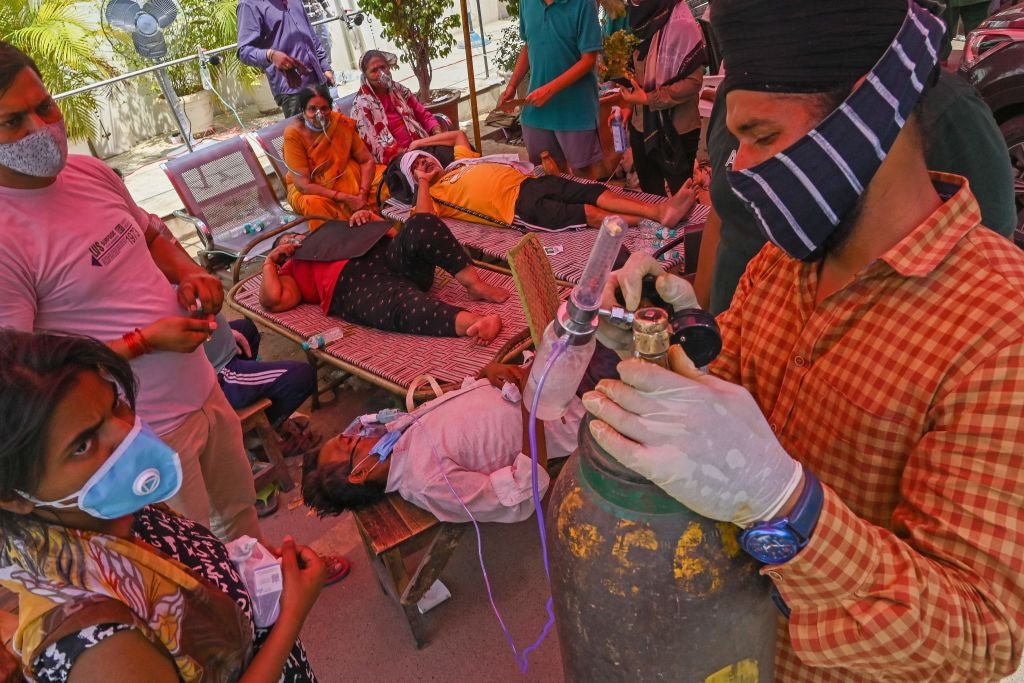Britain’s partnership with India is not going as planned
Following the chaotic and desperate scenes we have seen in the past few days, how keen will the UK government be to laud India as its prime partner for policy in the Indo-Pacific region, asks Mary Dejevsky


This was the week that Boris Johnson was supposed to be in India – and, given the news on the home front, he might well wish that he was. The original plan had been for a high-profile visit in January. It was postponed because of the surge of the pandemic in the UK, then rescheduled for April, then shortened, then called off because of the pandemic lockdown in India. Altogether not a happy tale.
But it is nothing like what India itself is going through. The harrowing pictures from New Delhi and elsewhere this week have been a reminder of the plight so many countries have faced during the Covid pandemic – of the despairing medics in Bergamo more than a year ago, of trolleys crammed into hospital corridors in New York City, and of what the UK managed largely to escape, thanks in part to its priority of “protecting the NHS” during the first wave of the emergency.
But there has been a particular immediacy about the reports from India, in part thanks to the diaspora in the UK, many of whom work for the NHS. Day after day, we have heard and watched their anguished phone calls with relatives a continent away. We have seen sick people begging to be admitted to hospital and turned away; people collapsing in the street, life-saving ventilators and oxygen bought and sold on an impromptu black market, and what happens when state and medical structures are overloaded and break down. We have been told that some pictures are too graphic to show. Doctors, here and there, relay the desolation of an all-out health emergency.
Meanwhile, we have also learned of the mass gatherings that may have contributed to the ravages of this virulent second wave, seen people queuing to vote, apparently ignorant of the risks, in elections that have been allowed to go ahead regardless, and so on and on. Pleas for medical supplies and vaccines to be rushed in from richer and better-organised countries are slowly being answered, with the United States among the first to respond. The UK has sent 500 now-surplus ventilators, but says it has no surplus vaccine – but even if it had, is there a system, you have to ask, that would be able to use it just now?
All of which forced the UK government’s hand. In the end, it was less surprising that Boris Johnson’s visit was called off, than that the cancellation was left so late and that so much time was allowed for those with the determination and the money to beat the deadline for the “red zone”. That it was left so late, however, and perhaps to the detriment of health in the UK, reflects how much was riding on the prime minister’s visit.
It had been planned as Johnson’s first major foreign visit after the pandemic shutdown – indeed, his first since his sweeping election victory of 2019, and since the Brexit transition period had ended. In its first incarnation, in January, it was to have been several days of showing the flag, including attendance at India’s annual Republic Day celebrations.
Johnson himself said it would usher in “an exciting year for Global Britain” and help bring about a “quantum leap” in the UK’s ties with India, which was an “increasingly indispensable partner” and a “key player in the Indo-Pacific region”. By preceding any visit Johnson might make to meet the new US president, or say to Berlin or Brussels, it would send at least two pointed messages about Brexit Britain’s new diplomatic priorities.
First, it was envisaged that there would be a wide-ranging free trade deal – something that was not possible when the UK was part of the EU, but would be quite an achievement, given that other countries, and not just the UK, have found negotiating trade agreements with India nigh-possible. India is seen as a complex and protected market, but also as a major hope for future growth as Europe ages. Delhi had also made clear that it was seeking a quid pro quo for any deal in the form of much more generosity from London in dispensing visas. Many were watching – on both sides – to see quite how generous the UK was prepared to be.
And second, the trip – which seemed designed to incorporate some of the pomp more commonly associated with a state visit – could be seen as a standard-bearer for the UK’s post-Brexit foreign policy. The integrated review of foreign and security policy, which was finally published last month, included a new “tilt” towards the “Indo-Pacific”. Here was to be the embodiment of that “tilt”, in which India – as the biggest and fastest-growing, if not the richest, partner – was to take an honoured place. Europe, in contrast, barely featured, while the US was primarily seen through the prism of Nato.
Now, that plan – that gamble, perhaps – must be called into question, if it is not actually in tatters. India has not been pleased by the multiple postponements and downgradings of Boris Johnson’s visit, nor by the designation of India as a “red zone”. It looks highly doubtful that Johnson’s India trip can be squeezed in before June, when the Indian prime minister, Narendra Modi, comes to Cornwall as a guest at the UK-hosted G7 summit.
Nor, though, can it be taken for granted that Modi will be in a position to come or, indeed, that he will still be in power, given the popular discontent already raising its head. But the question goes both ways. How keen will the UK and its government now be to laud India as its prime partner for its policy in the region, given what is currently unfolding on our television screens?
In purely statistical terms, India has not done too badly in international comparisons, even if its reporting and record-keeping leave much to be desired. In terms of Covid-19 cases and deaths per million of its population, it is far down the tables, with 147 deaths per million, compared to the UK’s 1,903, and Brazil’s 1,806. It is down with Norway and some of the Gulf states. As with so many countries hit by the pandemic, however, India has seen its many, many weaknesses inexorably exposed by coronavirus. Neither its health system nor its state system has coped with this second wave; people feel deserted by the state, left on their own to survive, or not, as they can. India emerges as a needy supplicant; no model for anyone.
What sort of a partner does that make India for the UK in the near future? The two other guest invitations the UK has extended for the G7 are to Australia and South Korea. They are worlds apart from India. There has been talk of the US convening a “democracies” summit that would also have included India. Would it still?
The barely hidden agenda behind the UK’s “tilt” to the Indo-Pacific, as behind the preferential aid the US has extended to India compared with closer and needier Brazil, is the hope that a grouping of like-minded states in the region can keep China in check. If the planned fulcrum of that policy was India – a high-tech, space-exploring, Asian tiger of a country – that is not the India we have seen in the past week, which is populous, ill-governed, chaotic, in many ways inhumane, and now potentially unstable to boot. Could it, should it, perhaps, be back to the drawing-board for US and UK foreign policy, with the whole idea of a “tilt to the Indo-Pacific” not far behind?



Join our commenting forum
Join thought-provoking conversations, follow other Independent readers and see their replies
Comments